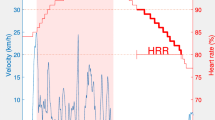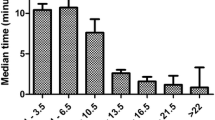Abstract
Aim
Endurance capacity of each individual soccer player can notably influence a team’s success. The opinion about the necessity of generic endurance specific training in soccer, especially in adolescent athletes, still varies widely.
Methods
We examined n = 38 elite premier league youth soccer players from three different age groups and with a different amount of endurance specific training. Two identical graded incremental exercise tests were performed before and after a 5 weeks training intervention. Besides soccer specific training, the different groups absolved either 25–30% (U16 and U19) or < 5% (U17) of generic endurance specific training as well as soccer specific endurance training. After the training intervention the alterations of blood lactate concentration (La-), the individual anaerobic threshold (LT) as well as the 4 mmol/-1 threshold were determined.
Results
Running velocity of the U16 and U19 players at individual anaerobic threshold and at the 4 mmol/-1 threshold increased significantly. In contrast, no changes of the LT or 4 mmol/-1 threshold could be detected for the U17 players.
Conclusions
The individual endurance capacity of young elite soccer players can be improved significantly, even over a short preseason period, by performing an adequate amount of generic endurance specific training.
Similar content being viewed by others
References
Ahmaidi S, Collomp K, Caillaud C et al (1992) Maximal and functional aerobic capacity as assessed by two graduated field methods in comparison to laboratory exercise testing in moderately trained subjects. Int J Sports Med 13: 243–248
Amigo N, Cadefau JA, Ferrer I et al (1998) Effect of summer intermission on skeletal muscle of adolescent soccer players. J Sports Med Phys Fitness 38: 298–304
Annoted bibliography appendices: international codes of ethics (1997) Bull Pan Am Health Organ 24(4): 582–629
Apor P (1988) Successful formulae for fitness training. In: Reilly T, Lees A, Davids K, Murphy W, Science and football. London, E & F.N., Spon., 95–107
Bangsbo J, Norregaard L, Thoroe F (1991) Active profile of competition soccer. Canad J Sport Sci 16: 0–6
Bangsbo J (1992) Time and motion characteristics of competition soccer. Science and football 1: 34–40
Bangsbo J (1994) The physiology of soccer — with special reference to intens intermittent exercise. Acta Physiol Scand 619(Suppl): 1–155
Brady K, Maile A, Ewing B (1995) An investigation into fitness levels of professional soccer players over two competitive seasons. J Sports Sci 13: 499
Casajus JA (2001) Seasonal variation in fitness variables in professional soccer players. J Sports Med Phys Fitness 41: 463–469
Chamari K, Hachana Y, Kaoueuh J et al (2005) Endurance training and testing with the ball in young elite soccer players. Br J Sports Med 39: 24–28
Dickhuth HH, Yin L, Niess A et al (1999) Ventilatory, lactate-derived and catecholamine thresholds during incremental treadmill running: relationship and reproducibility. Int J Sports Med 20:122–127
Dupont G, Akapo K, Berthoin S (2004) The effect of in-season, high-intensity interval training in soccer players. J Strength Cond Res 18: 584–589
Dunbar J (1999) Longitudinal change in aerobic capacity through the playing year in English professional soccer players. In: Fourth World Congress of Science and Football, Sydney, Congress Abstracts. Congress abstracts, Sydney, University of technology
Edwards AM, Clark N, MacFayden AM (2003) Lactate and ventilatory thresholds reflect the training status of professional soccer players where maximum power is unchanged. J Sports Sci Med 2:23–29
Hawkins RD, Fuller CW (1996) Risk assessment in professional football: an examination of accidents and incidents in the 1994 World Cup finals. Br J Sports Med 30:165–170
Hawkins RD, Hulse MA, Wilkinson C et al (2001) The association football medical research programme: an audit of injuries in professional football. Br J Sports Med 35: 43–47
Helgerud J, Engen LC, Wisloff U et al (2001). Aerobic endurance training improves soccer performance. Med Sci Sports Exerc 33:1925–1931
Hill-Haas SV, Coutts AJ, Rowsell GJ et al (2009) Generic versus small-sided game training in soccer. Int J Sports Med 30: 636–42
Hoff J, Kähler N, Helgerud J (2006) Training sowie Ausdauer — und Krafttests von professionellen Fußballspielern. Deutsch Z Sport Med 5:116–124
Impillizzeri FM, Marcora SM, Castagna C et al. (2006) Physiological and performance effects of generic versus specific aerobic training in soccer players. Int J Sports Med 27: 483–492
Kemi OJ, Hoff J, Engen LC et al (2003) Soccer specific testing of maximal oxygen uptake. J Sports Med Phys Fitness 43:139–144
Kindermann W, Coen B, Funck M (2002) Das Spielfeld lehrt das Spielen ! Leistungsphysiologische Daten und Spielverhalten im Kleinfeld bei jugendlichen Fußballspielern im Altersvergleich. Fußballtraining 20: 70–74
Little T, Williams AG (2005) Specificity of acceleration, maximum speed, and agility in professional soccer players. J Strength Cond Res 19:76–78
McMillan K, Helgerud J, Macdonald R et al (2005). Physiological adaptions to soccer specific endurance training in professional youth soccer players. Br J Sports Med 39: 272–277
McMillan K, Helgerud J, Grant SJ et al (2005) Lactate threshold responses to a season of professional British youth soccer. Br J Sports Med 39: 432–436
Meyer T, Coen B, Urhausen A et al (2005) Konditionelles Profil jugendlicher Fußballspieler. Deutsch Z Sport Med 1: 20–25
Roecker K, Striegel H, Freund T et al (1994) Relative functional buffering capacity in 400-meter runners, long-distance runners and untrained individuals. Eur J Appl Physiol 68: 430–434
Roecker K, Schotte O, Niess A et al (1998) Predicting competition performance in long-distance running by means of a treadmill test. Med Sci Sports Exerc 30:1552–1557
Roecker K, Niess A, Horstmann T et al (2002) Heart rate prescriptions from performance and anthropometrical characteristics. Med Sci Sports Exerc 34:881–887
Sporis G, Ruzic L, Leko G (2008) The anaerobic endurance of elite soccer players improved after a high-intensity training intervention in the 8-week conditioning program. J Strength Cond Res 22:559–566
Stolen T, Chamari K, Castagna C et al (2005) Physiology of soccer: an update. Sports Med 35: 501–536
Striegel H, Simon P, Hansel J et al. (2008) Determining aerobic endurance in middle distance runners during a 12-month period. O Sports Med J 2: 1–5
Van Gool D, Van Gerven D, Boutmans J (1988) The physiological load imposed on soccer players during real match-play. In: Reilly T, Lees A, Davids K, Murphy WJ, Science and football, London, E & F.N. Spon: 51–59
Weltman A (1995) The blood lactate response to exercise. Current issues in exercise, monograph number 4. Champaign, IL, Human Kinetics.
Wisloff U, Helgerud J, Hoff J (1998) Strength and endurance of elite soccer players. Med Sci Sports Exerc 3:462–467
Author information
Authors and Affiliations
Corresponding author
About this article
Cite this article
Best, R., Simon, P., Niess, A. et al. Influence of various preseason training in elite youth soccer players. cent.eur.j.med 8, 803–809 (2013). https://doi.org/10.2478/s11536-013-0236-8
Received:
Accepted:
Published:
Issue Date:
DOI: https://doi.org/10.2478/s11536-013-0236-8




